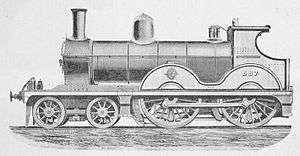GCR Class 2
|
Engraving of the No. 687 – the last Gorton-built example | |||||||||||||||||||||||||||||||||
| |||||||||||||||||||||||||||||||||
| |||||||||||||||||||||||||||||||||
| |||||||||||||||||||||||||||||||||
| |||||||||||||||||||||||||||||||||
The GCR Class 2 was derived from a Kitson (Leeds) built/Thomas Parker designed prototype 4-4-0 locomotive[2] No. 561, (the first single frame locomotive built for the MSLR) exhibited in Manchester in 1887. The design lead to the production of a series of express steam locomotives built between 1890 and 1894 for use on the Manchester, Sheffield and Lincolnshire Railway, later the Great Central Railway. The last batch of six, built 1894, had larger bearings for the coupled wheels, coil springs (instead of leaf springs) for the driving axle and was classified 2A.[3]
When first built, the Class 2s were used on the MSLR main express trains. They regularly hauled the Manchester to King's Cross expresses to and from Grantham. Early records suggest that they were very economical locomotives during this period.
These locomotives were superseded by the Pollitt D6 and Robinson D9 locomotives in 1895 and 1901 respectively, and were reduced to stopping and secondary services.
LNER ownership
They passed to the London and North Eastern Railway (LNER) in 1923 and both classes were re-classified D7. During the early years of the LNER (before 1928), the D7s qualified for the LNER's green passenger locomotive livery. This led to the Immingham D7s acquiring the nickname of 'Green Bogies' By this time, they were already obsolete - withdrawals starting in 1926 and progressed slowly, the last D7 was withdrawn in 1939 with no preserved examples.[4]
New locomotive
A Project has now been launched[5] to build a new member of this class (No. 567) to modern engineering standards (using metric steel and specifications) for running on the Great Central Railway (preserved). It will be a semi-new build locomotive, with a potential boiler, cylinder block and tender chassis already found, and the rest costing about £450,000.[6] The Bogie wheels are identical to those on the 'Brighton Atlantic Project', so the pattern for these could be utilised (courtesy of the Bluebell Railway) - other new-build projects based on Kitson design/manufacture may also have useful parts.
Investigations undertaken when creating the design for the new frames showed that these locomotives were structurally weak at the front end - photos show damage caused by 'heavy shunts'. The majority of their service life, these engines would have spent coupled to their trains via the tender - for use on preserved lines, the locomotive needs to be able to run Smokebox to train. The GCR567 design team will utilise the later Kitson & Co (1892) build for the frames - these later engines being built with slightly deeper frames[7] but the GCR567 team still needs to address the weakness - by creating a new front Dragbox - this and other modern updates to improve ease of maintenance, will not be seen from the outside, and will not detract from the visual re-creation of this Victorian Locomotive.
See also
References
- ↑ Baxter 1988, p. 192.
- ↑ Built to General Arrangement Drawing # 1239(9)(held by the new build group)
- ↑ Boddy, M.G.; Brown, W.A.; Hennigan, W.; Neve, E.; Platt, E.N.T.; Russell, O.; Yeadon, W.B. (January 1981). Fry, E.V., ed. Locomotives of the L.N.E.R., part 3B: Tender Engines - Classes D1 to D12. Kenilworth: RCTS. p. 54. ISBN 0-901115-46-0.
- ↑ "The Parker Class D7 (GCR Classes 2 & 2A) 4-4-0 Locomotives". Lner.info. Retrieved 2012-03-02.
- ↑ http://gcr567loco.co.uk/
- ↑ "News Output". GCR Rolling Stock Trust. Retrieved 2012-03-02.
- ↑ Built to General Arrangement Drawing #1034(8)(held by the new build group), for later class 2 Locomotives
- Baxter, Bertram (1988). Baxter, David, ed. British Locomotive Catalogue 1825–1923, Volume 5B: Great Northern Railway and Great Central Railway. Ashbourne, Derbyshire: Moorland Publishing Company. ISBN 0-903485-86-9.
